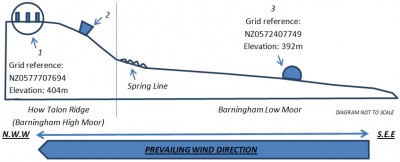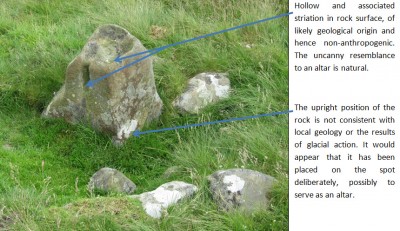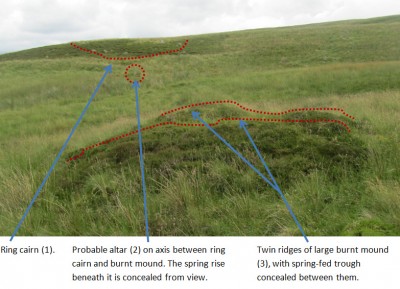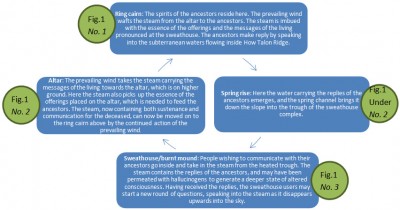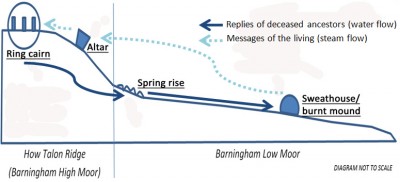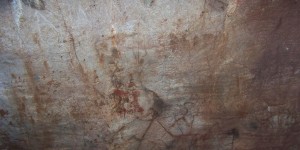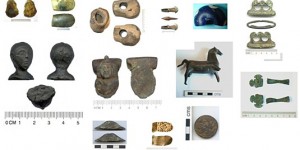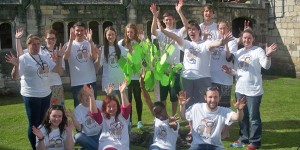Burnt mounds are among the most enigmatic archaeological features found across the British Isles. This paper provides an overview of current theories regarding their use, drawing on ethnographic comparisons with societies of varying complexity in North America, the Urals and the Teotihuacán cultural complex. A new approach to research and interpretation in this field is illustrated through a case study of a Bronze Age section of Barningham Moor, Teesdale, Yorkshire, UK, in which a burnt mound is analysed in the context of monuments and landscape features surrounding it. This example is used to support the view that burnt mounds were inherently multi-functional, and had ritual meaning symbolising connections with nature and the spirit world that were in no way less significant than their practical use.
Introduction
Burnt mounds, also known as Fulacht Fiadh in Ireland, are widely distributed throughout the British Isles. They consist of two low ridges rarely exceeding 1m in height, and separated by a distinctive trough. The overall diameter of the main feature rarely exceeds 9m, with trough volume typically near 1m² (Barfield and Hodder 1987, 371). Frequently the ridges are so inconspicuous that the entire monument can only be identified by vegetation growing over the underlying rock, which may differ substantially from the surrounding plant cover (Laurie 2003, 244). On excavation, such sites reveal numerous pieces of heat-cracked sandstone within the ridges, with the lithology indicative of repeated contact with water (Quinn and Moore 2007, 8). Usually these stones are accompanied by a thick layer of charcoal and evidence of hearths around the perimeter of the monument.
The central trough is always linked to a nearby stream, usually fed by a spring in the immediate vicinity of the burnt mound, thus indicating that its function was water storage. The trough may also be lined with wooden planks or clay to enhance the impermeability of its sides (Chapple 2007, 30). From this, one can infer that the sites were used to heat stones, which would then either be sprayed by water from the trough or thrown directly into it, considerably raising its temperature and likely generating vast quantities of steam. Many theories attempt to explain these activities: cooking, brewing, bathing and a host of ritual explanations have all been suggested. However, one observation is especially significant: construction of burnt mounds closely coincides with the beginning of the Bronze Age in the early 2nd millennium BCE (Brindley et al. 1989, 28).
The onset of the Bronze Age marked significant changes in social dynamics across European societies. New, metal agricultural tools led to cultivation of previously marginal land, including upland areas, sparking both population growth and providing opportunities for colonising previously uninhabited tracts (Kristiansen and Larsson 2005, 141). The Yorkshire Dales, which are particularly rich in burnt mounds, are a good example: long-term permanent or transhumant settlements were for the first time established high on the valley slopes, with the population living over a much wider range of latitudes and physical environments as compared to the Neolithic (Manby et al. 2003, 83).
New opportunities for travel, marked by bronze-induced advances in boat-building, cart manufacture and the advent of metal equine harnesses (Harding 2000, 170) enabled communities to widen their horizons even further, with both goods and people moving from Britain to as far as the Mediterranean coast, and vice versa (Scarre 2005, 421).
There may also have been a fundamental shift in the nature of religion: agriculture was continuously expanding at the expense of older hunter-gathering methods, and ethnographic studies of modern Siberian societies going through similar transitions suggest that this may have led to the replacement of itinerant, totemic faunal cults, with worship of inanimate elements of prime importance to early farmers, such as water, light and soil (Khlobystina 1971, 169). At the same time, increased efficiency in agricultural modes of production and more stable food surplus provision may have encouraged the development of a larger class of specialised priests, forming the basis of more regulated communal worship (Kosven 1957, 206). The very nature of early bronze smelting may have enhanced this further: smiths producing the all-important metal through control of fire were perhaps important figures within the new cults, seen as individuals whose esoteric knowledge allowed them to blur the boundaries between practical and spiritual aspects of daily life (Budd and Taylor 1995, 140).
It is at this important time of change in both material and probably spiritual culture that burnt mounds first appear in the archaeological record of northern Europe and the British Isles, and their close spatial correlation to finds of Bronze Age metalwork has recently been highlighted, further emphasising this point (Laurie 2003, 246). An outline of different interpretations, and how they may fit in to this wider framework of gradual social transformation, is given below.
Burnt mounds as cooking places?
Perhaps the most common interpretation, dominating burnt mound research until the last two decades of the twentieth century, argued for a function of boiling or steaming food (Barfield and Hodder 1987, 371). Recent studies of sites in Ulster, Ireland, led to an experiment in which a reconstructed burnt mound of standard size was shown to successfully boil a full trough of water in 35 minutes, potentially providing a quick and straightforward way of cooking vast quantities of meat without risk of burning it on open flames (Chapple 2007, 32).
Further corroborating evidence is found in Geoffrey Keating’s early seventeenth century history of Ireland, Foras Feasa ar Éirinn, which describes a pre-Christian tradition of hunters boiling meat in earthen pits, and a late medieval ecclesiastical biography of the Irish St. Munnu, describing the boiling of porridge on fire-heated stones (O’Neill 2003, 80). Interesting comparisons have also been made with descriptions of food boiling in medieval Norse and Icelandic compositions (Barfield and Hodder 1987, 378). In recent years, this hypothesis has been further developed by suggestions that troughs could be used to sparge wort for early mead brewing (Quinn and Moore 2007, 9), perhaps alongside conventional cooking.
The cooking hypothesis is, however, rendered less convincing by the near absolute lack of animal bone or plant material within the troughs, and the finds which have been made appear to belong to later archaeological strata (Barfield and Hodder 1987, 371). Moreover, the location of many burnt mounds on marshy upland terrain makes the notion of cooking somewhat unlikely: the prospect of carrying large quantities of food to such inconvenient areas seems unappealing (Brindley et al. 1989, 25). Proponents of this view have argued that the lack of animal material is likely due to preferential decay associated with elevated soil acidity, which is a key feature of burnt mound sites (Chapple 2007, 32). Similarly, one can argue that the current terrain surrounding burnt mounds does not reflect the Bronze Age landscape, with sites easier to access at that time. The related brewing hypothesis has also been bolstered by finds of Middle Bronze Age food vessels containing probable mead residues on Machrie Moor, Arran and across Perthshire, Scotland (Quinn and Moore 2007, 9).
Even accepting the taphonomic explanation for a lack of organic remains, it must still be noted that sites would only be worth the labour investment of creating them if very large amounts of food or beer required processing very rapidly (Brindley et al. 1989, 25). For instance, a standard burnt mound used for brewing purposes could produce an estimated 110 litres of beer if its trough were fully filled (Quinn and Moore 2007, 11). This would require a demand which small-scale subsistence economies of the north European Bronze Age were unlikely to produce.
Considering this, it also seems possible to interpret the writings of Keating and the ecclesiastical historians differently (O’Neill 2003, 81): writing many millennia after the structures had come out of use, they may have merely been making educated suggestions based on their own experiences of larger scale food production. Consequently their work may not offer a reliable indication of genuine practices (Chapple 2007, 32).
Finally, it is worth adding that the cooking hypothesis fails to explain why burnt mounds should have arisen specifically in the Early Bronze Age, and why this method had suddenly become preferable to earlier techniques used in the Neolithic. Overall, while the cooking hypothesis can by no means be discounted, there is ample scope for alternative interpretations.
Burnt mounds as sweathouses?
An alternative interpretation that has gained popularity in recent years is that burnt mounds are the remains of Bronze Age sweathouses (Laurie 2003, 224). The ridges may have supported a simple, possibly portable wooden carcass covered with hides (Barfield and Hodder 1987, 372); such structures are described in Herodotus’ Histories in an ethnography of 5th century BCE Scythian people, and it is possible that the sweathouse tradition extended across much wider sections of Europe in the Bronze Age.
More recent ethnographic comparisons have been made to the sweathouses of Missouri Mandan Indians (Laurie 2003, 244), noted for making small enclosures of furs pulled over a wooden framework, covering hearths with stones placed over them. Water poured over the stones generates vast quantities of steam within the small space, which may contain up to three people (Kosven 1957, 150). Similar buildings have also been found until comparatively modern times in isolated societies of northern Russia, Finland and Ireland (Barfield and Hodder 1987, 373), underlining just how widespread the phenomenon is.
Proponents of the sweathouse idea argue that the lack of finds on burnt mound sites fits the ephemeral nature of a timber superstructure (Laurie 2003, 246). It can also be argued that their isolated location would be much more appropriate for secluded bathing than for large-scale food processing, with its associated logistical issues. Furthermore, a 1m² water trough may be too large for standard cooking purposes (Brindley et al. 1989, 25), but might be a much more suitable size for wallowing or simply generating a steam cloud to trigger perspiration.
However, this interpretation on its own still leaves many unanswered questions. Firstly, from an archaeological perspective the physical remains of known sweathouses from the cultures cited above cannot be easily matched to burnt mounds (Kosven 1957, 150). Moreover, as with the cooking hypothesis, there is no obvious reason as to why sweathouses should have gained popularity at the start of the Bronze Age, or why their locations should correlate to finds of contemporary metalwork (Laurie 2003, 246).
Having said this, the interpretation does become more convincing once its major ritual connotations are taken into account. In all these ethnographic studies, it has been found that the process of immersion in steam has great ceremonial and spiritual value, with the vapours often being imbued with hallucinogens such as cannabis or agaric mushroom extract (Kosven 1957, 150). Consequently, the sweathouse may be seen as a place providing not only physical purification, but also an “inner cleansing of mind and spirit” (Laurie 2003, 224). In this context, the appearance of burnt mounds during the Bronze Age becomes easier to explain: they may have been part of the wider changes in theology and worship that were characteristic of the period. This crucial ritual aspect, centred on now-intangible belief and ceremony (Leroi-Gourhan 1964, 86), is discussed in the next section.
Possible ritual aspects of burnt mound use
Interpretations stressing the ritual role of burnt mounds are normally broadly concurrent with the sweathouse hypothesis (Laurie 2003, 224); however the emphasis is on the symbolic rather than the practical. The possible ethnographic parallel with the Mandan Indians shows how the sweathouse may be deemed a portal into a spiritual beyond - hot, steamy conditions are combined with cannabis to generate an altered state of consciousness, where participants may not recognise one another as humans but instead perceive their companions as spirits, or interpret the sound of water as speech emanating from another world (Kosven 1957, 150).
Another example is the sweathouse cults of southern Siberia, still prevalent in early modern times, which are associated with “cosmic chase” theology (Khlobystina 1971, 173). In traditional belief, each day the sun is hounded and eventually swallowed by a bear-like demon, but re-emerges in the morning to start the cycle afresh. The sweathouse transfers this theology to the individual: participants enter dirty and enveloped in chaos, like the sun at dusk, but exit fresh and reinvigorated, like the sun at dawn.
Consequently, the sweathouse is acting as a “micro-cosmos” (Leroi-Gourhan 1964, 88), embodying the entire world order in a definable sacred space which offers a fresh start and new hope to whoever may enter. Such sweathouses are also used to communicate with the celestial elk, a theriomorphic deity believed to carry the sun on its horns (Ivanov 2010, 65). These examples from recent ethnographies would therefore suggest that if burnt mounds did indeed have a sweathouse function, they would almost certainly have had ritual significance.
Alongside generating altered consciousness, it is worth considering the role of water more generally within the burnt mound complex. Water-based religions were prominent in the Bronze Age of northern Europe (Manby et al. 2003, 95), as evidenced by the numerous documented finds of underwater metal offerings, and recent ethnographic studies in Siberia which highlight spiritual links between rivers and the netherworld up to the present day (Ivanov 2010, 37).
However, perhaps most significant is the proximity of almost all known burnt mound sites to spring rises (Laurie 2003, 224), which may be interpreted as gateways into parallel subterranean existence. A relevant ethnographic comparison may be the classic phase of the Mesoamerican Teotihuacán cultural complex (Millon 1993, 22): an entire city centred on a spring located beneath the famous Sun Pyramid. The spring emerged from a cave believed to be the cradle of humanity, and formed a liminal zone between the earthly world of the living and the watery world of the deceased (Sugiyama 1993, 112). The orientation of all the buildings in the city was closely connected with the direction in which the spring waters flowed (Linné 1934, 34), and altars to running water were frequently set up in the domestic compounds (Manzanilla 1993, 96). Thus, the Teotihuacán example illustrates how springs may be steeped in theology and cosmology, and adds an extra dimension to ritualistic interpretations of cult activities at burnt mound sites.
This is supported by folklore linked to springs in Yorkshire, an area especially rich in burnt mounds, where such places were believed to have magical powers ranging from curing chronic disease to stimulating fertility and erotic love (Matthews 2011, 64). A sweathouse on a spring would therefore likely be a very potent spiritual focus, which fits in with the overall framework of probable theological change at the onset of the European Bronze Age.
Finally, it is worth briefly looking at burnt mounds from a perspective of ritual concentricity: the steaming trough in the centre, warm ridges around it, and a cooler world outside. Thus, the space may have become increasingly sacred moving inwards, with the spring perhaps deemed so holy that it was left a short distance outside the burnt mound. Alongside these three main concentric levels, it is noteworthy that a number of burnt mound sites, like this writer’s study area on Barningham Moor, Yorkshire, are surrounded by stones marked with concentric ring patterns (Laurie 2003, 238). These stones occur within the same concentric landscape of anthropogenic monuments, and may have enhanced its ritual significance.
While the precise meaning of this possible correlation cannot be established, it certainly may indicate that the entire area encompassing the burnt mounds was in some way magical. An ethnographic parallel may also be drawn with the trance dances of the San people of the Kalahari desert (Connah 2005, 359), whose concentric rings of rock art represent entoptic phenomena - spirals which are apparently seen by participants in cult rituals involving the inhalation of smoke.
Meanwhile, a vast belt of Neolithic concentric rock art sites, which spreads across the centre of the former USSR, has been linked to astral observation (Golendukhin 1971, 186). All in all, it is possible that ceremonies within the vicinity of burnt mounds may have been linked to the surrounding landscape, as symbolised in the rock art.
Case study: a possible ritual complex focussed on a burnt mound on Barningham Moor, Teesdale, County Durham, UK
This range of ritual interpretations, alongside possible utilitarian aspects of burnt mound usage, may be best illustrated by the following case study of one line of monuments beneath How Talon Ridge on Barningham Moor (Figure 1).
- Ring cairn with central standing stone (Figure 2), arranged as a probable Middle Bronze Age burial complex overlooking the main valley floor.
- Probable non-anthropogenic altar (Figure 3) beneath ring cairn and above spring line, overlooking burnt mound and on a straight axis between ring cairn and burnt mound.
- Large burnt mound (Figure 4), over 14m in diameter, at the foot of How Talon Ridge.
Site description and interpretation
As shown on the preceding diagram (Figure 1), the author proposes that the southeastern slope of How Talon Ridge on Barningham Moor contains an axis of Bronze Age monuments aligned in the direction of the prevailing wind. On the highest ground, there is a ring cairn of likely funerary function, not dissimilar to the larger, excavated mortuary centre at Danby Rigg, Yorkshire (Manby et al. 2003, 89), with a single standing stone a little lower down on the same slope. The shape of the stone is natural, but its upright position is the result of human effort, which adds credibility to the author’s view that it may be a non-anthropogenic altar integrated into the wider monument complex. Beneath the standing stone, which is less than 1m in height, is a spring line marking the transition from subsurface drainage under the Great Scar limestone of How Talon Ridge to surface runoff over the quaternary deposits of Barningham Low Moor (Gaunt and Buckland 2003, 18). Beyond where the spring rises, there is a large burnt mound placed atop the impermeable geology and still on the same alignment.
A new ritual framework (Figure 5) shall now be proposed for interpreting these sites, which may shed new light on the wider usage of burnt mounds in other areas. The hypothesis is inspired by ethnographic studies of Siberian societies, including their use of sweathouses (Ivanov 2010, 69). In the Siberian cultural complex, which remained broadly intact until the 16th century and still retains influence among the modern indigenous population, water in its different states is frequently associated with the netherworld and may serve as a means of communication with deceased ancestors (Kosven 1957, 165). The Barningham Moor burnt mound, with its likely connection to a spring, an altar and a funerary monument, appears to match this ethnographic parallel. It may have provided a sacred space used to initiate a cycle of communication with the spirit world of the dead (Figure 6), as outlined below.
Central to this interpretation is the observation that the prevailing wind blows in the opposite direction to the net water flow down How Talon Ridge, opening the possibility of a ritual hydraulic cycle on the slope. It is logical to assume that ring cairn burials were associated with ancestors and their spirits, while the burnt mound could generate altered states of consciousness among the living. With the waters flowing from ring cairn to burnt mound, and the prevailing winds travelling vice versa, the hydraulic cycle interpretation becomes a tempting possibility.
The case is further strengthened by the location of the likely altar, which may be a medial point between the two other sites, perhaps strengthening the messages of the living by imbuing them with the essence of the sacrificial offerings over which the steam passed. This matches the spiritual transformations linked to the Bronze Age, including the probable development of an enlarged social stratum of priests or magicians (Budd and Taylor 1995, 140), as discussed earlier. Consequently, while this hypothesis can in no way determine exact functions of burnt mounds, it does at least unlock a new spiritual dimension which goes some way towards explaining why the phenomenon is connected with the Bronze Age.
Discussion and concluding comments
While the above case study raises interesting questions about possible activities at burnt mound sites, it must be emphasised that research in this direction is still at a very early stage, so the views expressed here are above all a platform for future investigation. No excavation has been carried out on How Talon Ridge at the time of writing, and the features are undated, albeit Bronze Age in character (Manby et al. 2003, 89). A thorough analysis of the site, including archaeological confirmation of the funerary nature of the ring cairn and radiocarbon or thermoluminescence dates for all principal features, is needed before any firm conclusion can be attempted.
It is also desirable to begin a methodical review of other burnt mound sites across the British Isles and northern Europe, to see if this alignment with ring cairns or possible altar features occurs elsewhere. Such a project may not prove feasible, or at least be extremely lengthy, in the current financial climate. Moreover, the situation is not helped by large-scale industrial quarrying and gas pipeline construction infringing on prime burnt mound locations across the British Isles, particularly in Yorkshire (Mackey and Manby 2003, 122).
Nonetheless, when combined with the ethnographic evidence presented earlier, the How Talon Ridge case study does strengthen the already convincing view that burnt mounds were places of ritual significance. Their proximity to springs may highlight their role as gateways to an afterlife (Sugiyama 1993, 106), water may have been used as a form of communication with the spirits of the deceased (Ivanov 2010, 37), or some rite combining these possibilities may have been practised. The use of hallucinogenic substances is highly likely in this context (Kosven 1957, 150), and may be connected to concentric rock markings found near a number of burnt mounds, which could represent entoptic phenomena (Connah 2005, 359).
This ritualistic interpretation in turn leads back to the practical aspect of burnt mound usage. Overall, the sweathouse hypothesis is preferable to cooking in this context; ethnographically ceremonial purification in preparation to cross a liminal threshold is frequently accompanied by a physical cleaning of the body (Kosven 1957, 150), and the writer believes that such a process is a likely explanation of the burnt mound phenomenon. However, the cooking viewpoint cannot at this stage be definitively discounted, and there remains a distinct possibility that burnt mounds may in some ways have been associated with food preparation, although perhaps not as their primary function.
An excellent example supporting such multi-functionality may be found in the folkloric Irish Romance of Mis and Dubh Ruis, a Gaelic composition describing a hero who bathed a maiden in a pit of steaming water and deer fat to cure her insanity (Chapple 2007, 32). It has been suggested that this tale may have its origins in the Bronze Age use of burnt mounds, showing how the trough may have heated both humans and also animal tissue as part of purification rituals that may have involved ceremonial cooking (O’Neill 2003, 80). This well illustrates the continued need to engage with mythological and literary sources alongside the often inconsistent archaeological record and the wide range of ethnographic comparisons made earlier on.
Overall, an approach integrating these three research strands into a single, holistic line of investigation may yet yield further clues about the true uses of burnt mound monuments, but at the present time an explanation in terms of ceremonial interaction with water and its concealed spiritual messages perhaps appears the most compelling.
Bibliography
- Barfield, L. and Hodder, M. (1987) ‘Burnt mounds as saunas, and the prehistory of bathing’. Antiquity. 61. 370-379
- Brindley, A.L., Lanting, J.N. and Mook, W.G. (1989) ‘Radiocarbon dates from Irish Fulachta Fiadh and other Burnt Mounds’. Journal of Irish Archaeology. 5. 25-33
- Budd, P. and Taylor, T. (1995) ‘The faerie smith meets the bronze industry: magic versus science in the interpretation of prehistoric metal-making’. World Archaeology. 27. 133-143
- Chapple, R.M. (2007) ‘The excavations of a burnt mound at Ballywilliam, County Down’. Ulster Journal of Archaeology. 66. 21-38
- Connah, G. (2005) ‘Holocene Africa’, in C. Scarre (ed.) The Human Past. London: Thames and Hudson. 350-390
- Gaunt, G.D. and Buckland, P.C. (2003) ‘The geological background to Yorkshire’s Archaeology’, in T.G. Manby, S. Moorhouse and P. Ottaway (eds.) The Archaeology of Yorkshire: An assessment at the beginning of the 21st century. Leeds: Yorkshire Archaeological Society. 17-24
- Golendukhin, U.N. (1971) ‘Voprosy klasifikatziyi i duhovniy myir drevnevo zemledyeltsa po petroglifam Saymaly-Tasha [Classificatory questions on the spiritual world of the ancient arable farmer, based on the petroglyphs of Saimala-Tash]’, in R.S. Vasilievskiy (ed.) Pyervobyitnoye Iskusstvo [Prehistoric Art]. Novosibirsk: Science Publishing. 181-202
- Harding, A.P. (2000) European Societies in the Bronze Age. Cambridge: Cambridge University Press
- Ivanov, A. (2010) Khrebet Rossiyi [The backbone of Russia]. Yekaterinburg: Classical Alphabet Press
- Khlobystina, M.D. (1971) ‘Drevneyshiye yuzhnosibirskiye mify v pamyatnikah okunyevskovo iskusstva [Prehistoric myths of southern Siberia: artwork relics of the Perch People]’, in R.S. Vasilievskiy (ed.) Pyervobyitnoye Iskusstvo [Prehistoric Art]. Novosibirsk: Science Publishing. 165-180
- Kosven, M.O. (1957) Ocherki Istoriyi Pervobyitnoy Kyultury [Reviews on the history of prehistoric culture]. Moscow: USSR Academic Press
- Kristiansen, K. and Larsson, T.B. (2005) The Rise of Bronze Age Society. Cambridge: Cambridge University Press
- Laurie, T.C. (2003) ‘Researching the Prehistory of Wensleydale, Swaledale and Teesdale’, in T.G. Manby, S. Moorhouse and P. Ottaway (eds.) The Archaeology of Yorkshire: An assessment at the beginning of the 21st century. Leeds: Yorkshire Archaeological Society. 223-254
- Leroi-Gourhan, A. (1964) ‘Les religions de la préhistoire (religions in prehistory)’, in R.S. Vasilievskiy (ed.) Pyervobyitnoye Iskusstvo (Prehistoric Art). Novosibirsk: Science Publishing. 81-90
- Linné, S. (1934) Archaeological Researches at Teotihuacán, Mexico. Alabama: University of Alabama Press
- Mackey, R. and Manby, T.G. (2003) ‘The Iron Age in the Yorkshire region’, in T.G. Manby, S. Moorhouse and P. Ottaway (eds.) The Archaeology of Yorkshire: An assessment at the beginning of the 21st century. Leeds: Yorkshire Archaeological Society. 117-124
- Manby, T.G., King, A. and Vyner, B.E. (2003) ‘The Neolithic and Bronze Age: A time of early agriculture’, in T.G. Manby, S. Moorhouse and P. Ottaway (eds.) The Archaeology of Yorkshire: An assessment at the beginning of the 21st century. Leeds: Yorkshire Archaeological Society. 35-113
- Manzanilla, L. (1993) ‘Daily Life in the Teotihuacán Apartment Compounds’, in K. Berrin and E. Pasztory (eds.) Teotihuacan: Art from the City of the Gods. London: Thames and Hudson
- Matthews, R. (2011) Mysterious Yorkshire. Derby: DB Publishing
- Millon, R. (1993) ‘The Place Where Time Began’, in K. Berrin and E. Pasztory (eds.) Teotihuacan: Art from the City of the Gods. London: Thames and Hudson. 17-33
- O’Neill, J. (2003) ‘Lapidibus in igne calefactis coquebatur: The historical burnt mound tradition’. Journal of Irish Archaeology. 12/13. 79-85
- Quinn, W. and Moore, D. (2007) ‘Ale, brewing and


